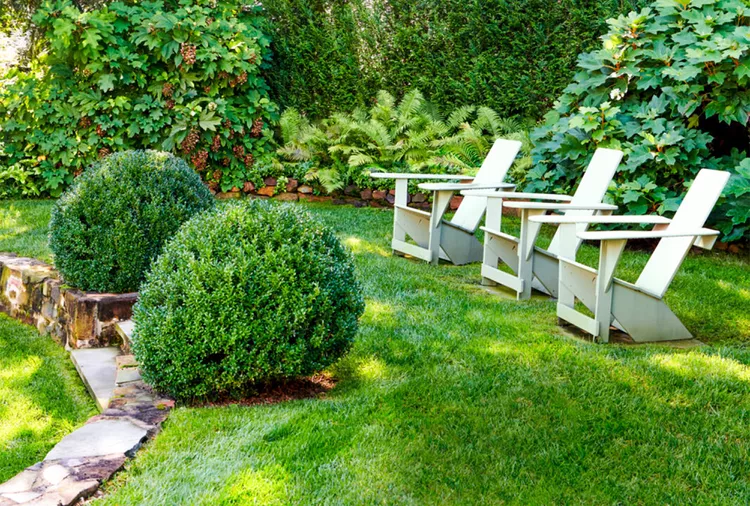Fertilizing your lawn is a little like making a cake—ingredients and accurate measurements are critical to success. Make a cake with salt instead of sugar and the result is inedible. Apply the wrong fertilizer to your lawn and you run the risk of long-term damage to both the turf and the environment. Fertilizer containing sulfur can help or hinder your lawn depending on the make up of your soil. Below, get all the details on sulfur, how it might benefit your lawn, and how to apply it, if needed.
Why Your Lawn Needs Sulfur
Turf grass thrives when adequate amounts of nitrogen, potassium, phosphorus, and several macronutrients, such as sulfur, and micronutrients are present. Each nutrient has specific functions in a plant. For example, sulfur is required for chlorophyll production in all plants. When a plant’s chlorophyll production is hindered, plants take on a yellow color.
The characteristics of the native soil, along with the climate, determine which nutrients are readily available to plants. For example, sandy soil in the western United States tends to have lower sulfur levels than sulfur-rich loam soil across the Midwest and Eastern United States. In fact, it's exceedingly rare to have low sulfur levels anywhere except the western United States.
How to Tell If Your Lawn Needs Sulfur
If you suspect a sulfur deficiency, take a soil test before applying sulfur-rich fertilizer. It’s important to note that sulfur is notoriously hard to measure; it moves through the soil quickly. While soil tests are poor at gauging sulfur availability, a test can identify other potential causes of weak growth. A lawn struggling with low sulfur availably will appear thin and yellow-green. A lawn lacking nitrogen looks very similar. A soil test can help sort out which nutrients are deficient.
In many areas, soil test kits are available from a local Cooperative Extension Service for a small fee. There are several commercial soil testing services too. When choosing a soil test kit, be sure the lab will test for sulfur levels.
While the test kits vary slightly, the process generally includes gathering a representative sample of the soil and then sending it to a lab for testing. The lab will then send you a summary of nutrient levels and the pH reading of the soil. Most soil summaries include suggested amendments for nutrient deficiencies and soil tips for growing specific plants, such as turf grass.
Types of Sulfur for Your Lawn
If a soil test identifies a sulfur deficiency, there are several sulfur-rich fertilizers. In fact, most complete lawn fertilizers will meet a lawn’s sulfur needs along with providing nitrogen, phosphorus, potassium, and many other nutrients. When shopping for a synthetic fertilizer, also called inorganic or chemical fertilizers, look for a product that has the word “sulfate” in the ingredient list. Common examples include potassium sulfate, ammonium sulfate, and magnesium sulfate.
When to Apply Sulfur
The best time to apply a complete lawn fertilizer is when grass is actively growing. Fertilize cool-season grasses, such as Kentucky bluegrass and fescue, in the fall after the heat of summer is passed and before freezing temperatures become the norm. Cool-season turf can be fertilized in spring as well, but fall applications are most effective. Warm-season grasses, such as Bermudagrass, zoysiagrass, and centipedegrass, all thrive when fertilized shortly after they green-up in spring. Aim to apply fertilizer prior to the intense heat of summer.
How to Apply Lawn Sulfur
Complete lawn fertilizers are available as easy-to-spread granules. Spread them using a walk-behind fertilizer spreader. Calibrate the spreader according to fertilizer package directions to ensure the product is applied at the proper rate. Spread fertilizer on a calm day and maintain a steady walking pace for even application.
Follow Label Directions
Using lawn fertilizers can result in lush, thick carpets of turf. These products also have the potential to harm the lawn and surrounding environment. Follow label directions carefully. Never exceed application rates or frequency. More is never better when it comes to fertilizer.
Natural Sources of Sulfur
Sulfur is naturally supplied to soil through the breakdown of organic matter. Grass clippings left on the turf will breakdown in time, releasing sulfur into the soil. While excessive amounts grass clippings can build up to create a detrimental layer of thatch above the soil line, finely chopped clippings can be beneficial.
Another natural source of sulfur is compost. Not only will compost supply sulfur but it will also improve soil structure. Spread a ¼-inch layer of compost over the lawn. A thin layer is essential—a thick layer can smother the turf. Incorporate the compost into the soil by going over the area several times with a soil aerator. Rent an aerator at your local home improvement store.




















